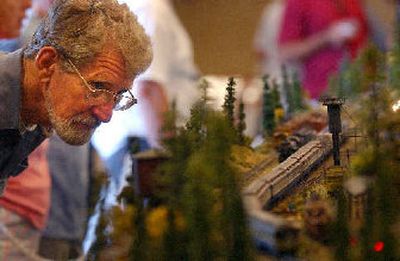Trains are always on time for these model railroaders

It is an ideal world these model-train enthusiasts inhabit – a world where locomotives from a bygone era pull rail cars laden with natural resources through the wide valleys and high deserts of the Pacific Northwest.
Their railways cross giant trestles spanning glacial rivers and disappear under broad mountains. Their trains pass through bucolic fields and bustling towns where sawmills and mines still fuel the local economy.
Middle-aged men who remember the first model trains their fathers bought them long ago – and the wives who indulge their childhood fantasies – now belong to clubs such as the Inland Empire N-Scalers and River City Modelers.
Over the weekend, many of the region’s model-railroader clubs and modeling enthusiasts gathered at the Pacific Northwest Region of the National Model Railroad Association convention at the Mirabeau Park Hotel in Spokane Valley.
Some brought the miniature worlds they created for their trains and tracks. Miniature may not be the right word. These “layouts” won’t fit under your bed when you’re done playing. They are roughly the size of an average living room. The clubs brought them in pieces, on planks and on plywood, in pickup trucks and in trailers. They put them together in a giant ballroom for visitors to see with wonder and awe.
Some offered their meticulous creations for competition, but not the members of the Salmon Arm (B.C.) Model Railroad Association. These men – having won best in show at the NMRA National Contest last year in Seattle – have nothing more to prove.
Their animated world filled the west end of the Spokane Valley hotel’s ballroom on Sunday, leaving other modelers behind at the station, so to speak.
Salmon Arm modeler Gary Hazell, 63, conducted a tour of 1:87 scale, or “HO”-gauge environment, that has taken 12 years to build.
First stop was the working lift-bridge, “scratch-built” out of brass with working semaphores on either side. Rock and rubble spill down from forested mountains that rise from the base of the platform on which the whole scene is built in modules.
The 54-inch-by-24-inch modules fit together in a particular way, Hazel explained, unlike other clubs’ displays in which each module can be placed willy-nilly, one depicting a pastoral setting, the next a battle scene.
The Salmon Arm club believes each scene must interact with the next to create a realistic world – in this case, a reproduction of rural British Columbia somewhere in the Monashee Mountains.
Local American clubs share modules while individual members own the locomotives and rail cars crafted from Lionel or American Flyer parts.
The Salmon Arm Model Railroad Association owns every piece of its display, all for the good of the club, not unlike the Canadian health care system. Each of its 18 members contributes his own special abilities, plus $60 a year in dues.
“I started when I was a little guy,” Hazell said, recalling the HO gauge locomotive his salesman father brought him long ago.
The next stop was a module containing replicas of two sawmills, lumber moving on conveyors to the saws. Smoke rose from a tepee burner nearby.
“We decided to add as much animation as we can without getting ridiculous,” Hazell said. As he spoke the fictional Shuswap and Monashee Railway freight train passed nearby, right on time.
Last stop was the fictional town of Monashee, where an exact replica of the Salmon Arm train depot sits in the middle of town.
A Chevy Corvette rotates on a turnstile in the town car dealership. A barber pole spins nearby. A stoplight changes from red to green to yellow. The revolving door at the Monashee Bar needs a new motor, but a hidden fan flutters a Canadian flag and spins a farmer’s windmill. Nearby, a crowd of townsfolk has gathered to watch firefighters douse a fire at the local movie theater, smoke rising into the air.
Much of the artwork for this display was painted by club members Jim Goldthorp and Bob Gardner, one of only 330 Master Model Railroaders in the world.
When the club’s display is not on the road, it is on exhibit at the Picadilly Mall in Salmon Arm.
This year’s convention, “Historic 2005 Spokane,” was sponsored by the Pacific Northwest Regional NMRA, the River City Modelers and the Inland Northwest Society of HO Modular Engineers. The River City Modelers’ annual swap meet will be Feb. 19 at Spokane Community College.